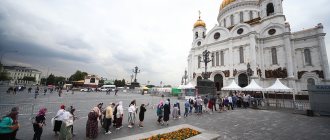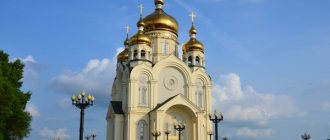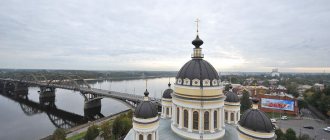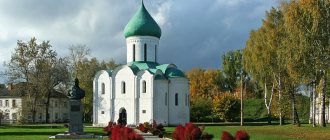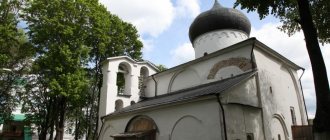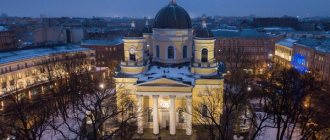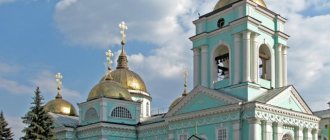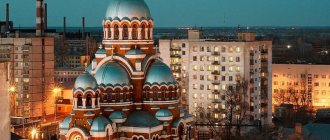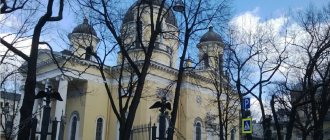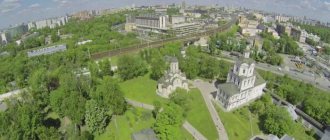Interesting dates
For a long time, this Orthodox church was considered the oldest among similar buildings dating back to princely times. Of course, we were talking about those that have survived to this day. However, recent studies have shown that the oldest is the St. Sophia Cathedral, whose employees stated back in 2010 that the latter was founded in 1011. And as proof they cited numerous inscriptions on its walls. Although this version has not yet been conclusively proven, some researchers are confident that the year when the Transfiguration Cathedral was founded in Chernigov is 1036.
TEMPLE OUTSIDE
The layout of the Transfiguration Cathedral is quite complex. In studies you can find different indications of the number of load-bearing pillars: the numbers are called eight, six or four. In particular, art historian A.I. Komech writes: “In the literature devoted to ancient Russian architecture of the 10th-15th centuries, it is common to define the structure of temples by the number of pillars: four-, six-, eight-pillars. Such a classification distorts the real compositional nature of the monuments, moreover, it incorrectly interprets the forms themselves. It is abstracted from the ideas associated with basilic buildings, and is violent for buildings of the cross-domed type. As a rule, all ancient Russian churches of the 11th-12th centuries. (except for the simplest ones) - four-pillared, they come with a narthex (the concept of it has almost disappeared from our architectural descriptions) or without it, with apses - either adjacent to the main nine-lobed structure, or having additional cells. The Transfiguration Women's Cathedral in Chernigov is a four-pillar church of the type of an inscribed cross, with a narthex and a developed altar part.”
The modern appearance of the cathedral is very different from the original. In the 11th century, the temple had only one tower - the northern one, and it was lower than the current one. The tower spiers were missing. The vestibules built at the portals in 1814 were also missing. The walls were not plastered. Their height before the leveling carried out in the 18th century was uneven. It is believed that this feature was a consequence of the different widths of the spindles: the zakomaras that end them begin at the same height, but since the spans are different, they rise unequally. You can see that the arches of the western spindles on the side walls of the naos run highest; in the eastern spindles, which are symmetrical to them, the arches go noticeably lower. Apparently, the principle of the arrangement of the roof was also different: in ancient times, the ceilings were everywhere under the roof, but now under the roof is observed only above the central sections of the walls. The facades of the building are made of extremely elegant brickwork with a hidden row. They are framed by pilasters, flat in the first tier and profiled in the second.
WALL MASONRY
Researchers of the Chernigov Cathedral Yu. Yu. Shevchenko and T. G. Bogomazova Fr. At the same time, a curious technique is encountered in the masonry: three plinths placed vertically on an edge are interspersed with stirrup plinths located horizontally - one above the other. Such masonry was not used in Byzantium.
WINDOW
In the tympanums of the central pillars of the cathedral walls there are triple windows, with the middle window slightly higher than the others. This architectural feature is quite common in Byzantine architecture. In the literature, this arrangement of windows is sometimes called “Byzantine”.
BRICK ORNAMENTS
“In the central apse, facades and north-western tower of the Spassky Cathedral,” we again quote Yu. Yu. Shevchenko and T. G. Bogomazova, “Christmas tree masonry (like the Roman masonry “in the ear”) was used.” They are characteristic of the architecture of the 8th-9th centuries of Crimea and Taman, the 9th-11th centuries of Volga Bulgaria, and are also known at this and later times in Central Asian architecture. The meander belt of the same cathedral tower is an even earlier element, consisting of Y-shaped double components (the second sign is vertically inverted).” This ornamental design is typical for buildings contemporaneous with the Spassky Cathedral in India and Central Asia.
History of creation
In 1024, the famous Chernigov prince Mstislav Vladimirovich the Brave won a victory in long internecine wars and began to significantly expand his possessions. His lands extended from Siverschyna to the North Caucasus. At this time, on the territory of Dneshny Grad, or Detinets, as it is now called, they began to build a very large princely courtyard. In this complex, the central building was the Transfiguration Cathedral in Chernigov, the history of which is inextricably linked with the history of Kievan Rus.
It is known that its founder died that same year. At the time of his death, the walls of the temple, as chroniclers testify, had already been raised to a height of four meters.
Completed during the reign of Svyatoslav Yaroslavich, the amazingly beautiful Transfiguration Cathedral in Chernigov became the main shrine of this land. It is here that many rare miraculous icons are kept and the relics of saints are buried.
After the death of Prince Brave, its founder, all craftsmen were removed from the construction of the cathedral. They were transferred to the construction of the Church of St. Sofia of Novgorod. Therefore, the Transfiguration Cathedral in Chernigov was completed only in the middle of the eleventh century.
THE BIRTH OF A MASTERPIECE
It is believed that Mstislav Vladimirovich the Brave, Prince of Chernigov, began the construction of the main temple of his capital around 1030 or, if we take slightly wider chronological boundaries, in the first half of the 1030s. By that time, he managed to reconcile with his brother, the Grand Duke of Kyiv Yaroslav the Wise, and firmly settled in the Chernigov region. The left bank of the Dnieper, according to the agreement between the brother princes, was in the full possession of Mstislav. Ancient Chernigov was supposed to become a worthy center of Mstislav's fatherland, a counterweight to Kyiv, a new political and cultural center of Rus'. In the Christian era, any large city, especially one that was destined for the capital, could not do without a magnificent cathedral.
The grandeur of the construction was determined by the level of the customer’s aspirations. The dimensions, shapes, external design of the temple and its interiors directly depended on how loudly the organizer wanted to announce himself to the outside world and how deeply his relationship with God was built.
MYSTERIOUS ARCHITECTS
It is obvious that the architects of the Chernigov Cathedral were foreign masters. Experts in the field of architecture call the spatial planning solution of the Transfiguration Church unique. Such designs are practically unknown in ancient Russian architecture. By the 11th century, the temple-building engineering thought of Christian Europe had developed two main types of temple: the more ancient basilica, which became especially widespread in Western and Central Europe, within the influence of the Roman Catholic Church, and the cross-domed one, characteristic of Byzantium and countries that experienced Byzantine influence. The Transfiguration Cathedral miraculously combined both traditions; this building simultaneously has the features of a basilica and a Byzantine cross-domed church. It is difficult to say who headed the team of architects: whether they were architects from some Catholic state, familiar with the intricacies of Byzantine construction technologies, or, conversely, Greek craftsmen who had mastered the skills of constructing basilica-type churches. It is sometimes claimed that Mstislav the Brave, who before Chernigov for a long time had a princely table on the outskirts of Russian influence, in the city of Tmutarakan, on the Taman Peninsula, invited craftsmen from there. The builders of the cathedral clearly knew about the principles of religious construction in Asia Minor and Transcaucasia, where similar temples are believed to have been built at that time. However, it is still more likely to see the Constantinople origin of the authors of the council. Researcher P. A. Rappoport suggested that the craftsmen who created the Transfiguration Church in Chernigov and St. Sophia of Kyiv represented the same artel, which was invited from the capital of Byzantium.
MONARCHICAL ASPECT
The question arises: why was the main cathedral in the domain of Mstislav the Brave consecrated in honor of the Transfiguration of the Lord?
Transfiguration is one of the most significant holidays of the Orthodox Church, celebrated on August 6 (19). It is one of the twelve holidays. The roots of special veneration of the Transfiguration of the Lord in Rus' go back to the era of Equal-to-the-Apostles Vladimir Svyatoslavich, Grand Duke of Kyiv, baptist of the East Slavic lands. The oldest indication of this is preserved in sources under the year 996. Chronicles report a battle between the army of Vladimir Svyatoslavich and the Pechenegs in the Kyiv suburb of Vasilevo. The prince's forces were small, he chose to retreat, but made a vow to rebuild the temple if the Pechenegs left: -
“Then Volodimer promised to build a church of the Holy Transfiguration in Vasilevo, for on that day there would be the Transfiguration of the Lord.”
The danger passed, and the Grand Duke of Kiev kept his word. Thus, the Vasilevsky Transfiguration Church became one of the first Orthodox churches built in Kievan Rus after the beginning of its Christianization, and the contemporaries of those events, newly converted Christians, found visible evidence of the patronage of the Lord. In the Middle Ages, people lived in a special atmosphere of miracles, which were perceived as everyday reality. Miracles and what is associated with them largely determined human activity. Therefore, the miraculous outcome of the confrontation on the day of the Transfiguration gave every reason to treat the holiday itself with special attention and reverence and, moreover, to associate the success of military enterprises with the Transfiguration.
The next significant stages in the development of the Transfiguration cult in Rus' date back to the 12th and 15th centuries. If we turn to history, we can come to the conclusion that the construction of Spassky churches and monasteries predominated during the years of the most serious changes in the political life of Rus': the collapse of the Kievan state and the establishment of new princely lines (XII century), and then the formation of a unified Russian state (XV century) .
Here are examples from the 12th century. Vladimir Monomakh, who founded or restored the city of Vladimir (on the Klyazma) in 1108, built the Transfiguration Church in it, which was the first stone structure in those places: -
“That same summer, Volodymyr Monomakh built the city of Vladimir Zaleshsky, and created in it the church of the stone of the Holy Savior.”
Somewhat later, in 1164, Andrei Bogolyubsky, the first prince of Vladimir, built the white stone Church of the Transfiguration of the Savior in the Monomakh courtyard in Vladimir. It is also known about the later existence of the Spassky Monastery in Vladimir on the site of the princely palace.
In the 15th century, the Preobrazhensky cult played a special role for the Moscow house of the Danilovichs. And this veneration began even earlier. The attention of the first Danilovichs to the Transfiguration is evidenced by the fact that the Moscow temple erected by Ivan Kalita (Prince of Moscow in 1325-1340), around which the court monastery of the grand-ducal family was formed, was dedicated to the Transfiguration of the Lord (Church of the Transfiguration on Bor in the Kremlin). According to chronicles, Ivan Danilovich Kalita had a special love for the Spaso-Preobrazhensky Monastery: he -
“I loved him more than other monasteries, and he often came to prayer for the sake of prayer and gave much alms to those who exist...”
The peak of the cult of the Transfiguration coincided with the era of Ivan III (he headed the Moscow state in 1462-1505) and was associated with the military activities of the Grand Duke, a tireless collector of Russian lands. On the day of the Transfiguration of the Lord, military campaigns began repeatedly, and prayers were performed in the Transfiguration churches for the success of military enterprises.
Thus, during the Russian Middle Ages a fairly strong Preobrazhensky cult can be traced.
The Transfiguration, which revealed to the world Jesus Christ the God, the King of kings, according to church understanding, had a clear monarchical aspect in the minds of the people of the Middle Ages. The increased attention to this holiday also reflected the sovereign aspirations of the princes; it symbolized the sacred side of their power.
In addition to the monarchical aspect, the Transfiguration of the Lord clearly had a military aspect. Let us remember that Mstislav was a major warrior of his time, and it was no coincidence that he received the nickname Brave. In 1031, together with Yaroslav the Wise, he made a successful military campaign against Poland, from where he returned with rich trophies and a large number of prisoners. It is quite possible that the foundation of the Transfiguration Cathedral in Chernigov reflected not only the monarchical, but also the military Christian views of Mstislav, and the reason for the dedication of the main temple of Chernigov was the Polish campaign of 1031. By paying tribute to the Transfiguration, Mstislav could build a bridge between himself and his father, Grand Duke Vladimir Svyatoslavich, thereby emphasizing the continuity of power.
Meaning
For almost nine centuries it was the cathedral for the local diocese. It was considered the center of state and public life. Many princes and spiritual rulers are buried under its arches. Here lie the relics of Prince Mstislav the Brave, as well as Svyatoslav Yaroslavovich and his sons Gleb and Oleg. In 1246, the holy martyrs Michael and Feodor were buried here. However, in 1572, by order of Tsar Ivan the Terrible, the relics were transported to Moscow.
Some researchers believe that it was here that Prince Igor, the hero of “The Tale of Igor’s Campaign,” was buried. He ruled Chernigov from 1198 to 1201. Hierarchs of the local diocese Lazar Baranovich and Ambrose Dubkevich are also buried here. In the era of ancient Rus', the cathedral housed one of, perhaps, the most revered icons in Rus' - the Smolensk Icon of the Mother of God, or Hodegetria. True, after a while Vladimir Monomakh transported the shrine to Smolensk.
Origin of the name and its meaning
The Feast of the Transfiguration of the Lord is one of the most important holidays for the Orthodox Church. It belongs to the twelve holidays, which are next in importance after Easter, and is celebrated on August 19.
The holiday itself was established in memory of the Transfiguration of the Lord on Mount Tabor, when He appeared to His chosen disciples in His heavenly glory, now combining both human and spiritual principles. It is celebrated by both the Eastern and Western churches, but for Russian people its celebration has a particularly important status.
The second name of the holiday is Apple Savior, and it is only in Russian, since only in Rus' apples are blessed on this day, and not grapes, as was customary in Constantinople. The Russian Church intertwined the Transfiguration with separate traditions. On this day, strict fasting was relaxed, fish and butter were allowed, and even before this day, any fruits and vegetables were prohibited, only cucumbers were allowed.
To celebrate the Transfiguration, apples were imported everywhere and sold like hot cakes. Everyone who had their own apples or could buy them considered it great happiness to be able to distribute the apples consecrated in the church to their servants, poor or sick people.
The special status of the holiday, its inclusion among the greatest and good traditions of food, along with the permission now to eat everything that grows in the garden, led to the construction of cathedrals and large churches in honor of this church celebration.
General form
The Transfiguration Cathedral in Chernigov, the plan of which shows a rather large three-nave structure with three apses and six pillars by ancient Russian standards - 18.25x27 meters - was rebuilt several times. In the eighteenth and nineteenth centuries, for example, two turrets were added to it. And only after this the Transfiguration Cathedral in Chernigov received its current appearance.
The perimeter facade is composed of extremely elegant masonry, made of hidden bricks. It is decorated with original pilasters, and in the first tier they are almost flat, while in the second they are profiled.
The spatial layout of the Transfiguration Cathedral in Chernigov (every person who comes to the city brings a photo of it home) is truly unique. No ancient Russian temple has such an original design.
As a result of excavations, it was revealed that small chapels were attached to the eastern corners of the main building, which have not survived to this day. And today the Transfiguration Cathedral in Chernigov, the photo of which is proof of this, stands without them.
The round tower adjacent to the porch on the north side has not survived either. A staircase led from it to the choir. And from the south, a three-apse church was originally built, which was a baptismal church. In addition, when in 1239 the cathedral was practically destroyed during the Mongol-Tatar invasion, the domes and vaults fell.
Iconostasis of the Transfiguration Cathedral
Surprisingly, the iconostasis, built after the great fire, has been preserved in full value in the cathedral. It is known that the iconostasis was created in the city of Nizhyn by local masters Savva Voloshchenko and Stepan Belopolsky. The iconostasis project was created by Ivan Yasnygin, a provincial architect. A priest from Borzna, Timofey Mizko, was appointed for the painting.
The iconostasis itself is a linden frame 12 m high and 20 m wide, fully decorated with paintings and carvings. Work on it was delayed and lasted more than 2 years. The iconostasis occupies the entire height and width of the temple; it is divided into three sections - for each of the chapels of the temple.
It has two tiers of icons, the background of the iconostasis is silver, and the protruding columns, cornices, etc. are trimmed with gold. For the central chapel in the iconostasis, the Royal Doors are especially highlighted and decorated: oval opening doors with a gap between them and the rest of the iconostasis.
The height of the gate is approximately 7 arshins, which is about 5 m. In the gap above the gate there is a figurative image of the Holy Spirit in the form of a dove. A total of 63 icons were painted for the iconostasis.
The complexity, duration and attention to detail in such work led to the fact that the amount allocated for the iconostasis was completely insufficient.
According to information from that time, there was only enough money left to pay for the work of the craftsmen, no more.
Then the local bishop sold the foreign coins that were stored here as donations to the already closed and abolished monasteries.
This amount was enough to pay the remaining expenses, and work on the iconostasis was completed.
For modern historians and cultural experts, the iconostasis is of interest and has undoubted cultural importance. It is regularly studied by researchers of antiquity, both in Ukraine and abroad.
The iconostasis has reached our time without a single alteration and is the same as it was originally, with the exception of the restoration of the icons.
Architectural solution
The Transfiguration Cathedral in Chernigov, whose style is a combination of the cross-domed Byzantine church with some elements of a Romanesque basilica, is extremely beautiful. During its construction, the craftsmen used mixed masonry technology. At the same time, natural stone was used along with plinth, a thin baked brick characteristic of ancient Russian architecture. Architects who have studied the principles and technologies of construction note with admiration that the constructive solution of the cathedral is surprisingly clear, almost ideal.
Photo[edit]
- Transfiguration Cathedral
- Transfiguration Cathedral
- Transfiguration Cathedral. Interior
- Transfiguration Cathedral. Interior
- Transfiguration Cathedral
- Transfiguration Cathedral
- Transfiguration Cathedral
- Transfiguration Cathedral
- Transfiguration Cathedral
The influence of time
Over its almost thousand-year history, this ancient cultural monument has undergone numerous destructions and reconstructions. During the years when Chernigov was taken by the army of Khan Mengu in 1239, the cathedral was completely plundered. According to legend, it was here that the last defenders of the fallen city closed in defense. The defense of Chernigov was led by Prince Mstislav. His wife, in order not to fall into the hands of the enemy, jumped out of the windows of the red tower of the cathedral.
The episcopal see was moved from Chernigov to the city of Bryansk. And only in 1675, under Archbishop Lazar Baranovich, restoration work began. Then the apses were built on.
Reconstructions
The next major reconstruction of the temple was carried out in 1791-1798, after a fire, when the building was badly damaged. It was at this time that many ancient Russian frescoes were lost.
Chroniclers write that in 1783 Potemkin was passing through Chernigov and became very interested in this cathedral. And as a result of his petition, sufficient funds were allocated for repairs. However, unfortunately, the restructuring did more damage to the temple. It caused damage that even all the previous destruction could not do.
Then two pointed towers were built on the sides of the cathedral. This began to give the cathedral a certain resemblance to a church. In addition, they served as a sundial.
Interior
In the interior decoration of the cathedral one can feel a solemn and strict combination of verticals and horizontals. Particularly worth noting are the very ancient relics, such as the frescoes and reliefs on the parapets of the choirs, as well as the original columns. Unfortunately, not everything from the pre-Mongol decoration of the temple has been preserved, and what has come down to us is saved in fragments and does not look the best. The main part of the interior paintings was destroyed by fire in the mid-eighteenth century.
The famous fresco “Equal to the Apostles Thekla” was removed by the Bolsheviks back in the 30s, then it was destroyed during the Second World War. The remaining few, but very ancient paintings stand out in spots from under the poorly distinguishable pattern of frescoes of the nineteenth century. It turns out that the interior of the cathedral was painted again in 1820, and half a century later it was updated. It was then that the ancient drawings died.
As a result of research inside the cathedral, residual pieces of the floor, made at different times, were discovered. The original covering consisted of slate slabs with an inset design filled with mosaics. One of its main elements are concentric circles. Initially, the floor inside the altar was laid with ceramic glazed tiles. However, already in the twelfth century it was replaced by smooth slate blocks. The slate reliefs on the choir parapets are of particular cultural and historical value.
In the interior, the elongated room is perfectly combined with two-tiered internal arcades that soar into the domed space. Along their entire length, wooden floorings were initially installed for the northern and southern choirs. They reinforced the horizontal division of the interior decoration. Similar arcades are more typical of Byzantine architecture of that era. However, they were rare during the times of Kievan Rus. And this is one of the characteristic features for which the Transfiguration Cathedral in Chernigov is famous, which in the splendor of its decoration was in no way inferior to the famous mother-throne churches.
THROUGH CENTURIES
For more than nine centuries, the Transfiguration Cathedral was the spiritual center of the Chernigov land. In addition to its ecclesiastical role, it had great political and social significance. Under the arches of the temple, solemn bishops' services were performed, the shrines of the Russian Church were brought here, here the princes swore allegiance to each other and resolved the most important issues of state life.
The first evidence of the Transfiguration Cathedral dated by historical sources dates back to 1034 (or 1036). In The Tale of Bygone Years we read: -
“Mstislav went fishing and got sick and died. And having placed the Holy Savior in the church, he created it himself, for it was given out in front of him on high, like a dozen standing on a horse.”
This testimony is translated as follows: “Mstislav went hunting, fell ill and died. And they laid him in the Church of the Holy Savior, which he himself created: after all, with him, its walls were built as high as you can reach with your hand while standing on a horse.”
This quick note from the ancient Russian chronicle is doubly remarkable. It not only confirms that it was Mstislav Vladimirovich the Brave who ordered the construction of the Chernigov Cathedral, but also notes a curious intermediate stage of work. Probably by 1034 (or 1036), judging by the indication that a rider standing in stirrups could reach the top row of masonry at that time, the height of the cathedral walls was about four meters. If the construction of the temple was carried out without interruptions and long stops, this state of the building, given its size, most likely could have been achieved in at least a couple of construction seasons (climate conditions determined that construction work could only be carried out during the warm season).
However, some researchers believe that the phrase “be bo” refers the message about the unfinished temple to the previous phrase - to the moment of its foundation, and not to the moment of Mstislav’s burial in the completed temple. Taking into account a number of indirect signs, these scientists propose a new dating: by 1034 (1036) the cathedral had already been built, its lower part, those same four meters, appeared even before Mstislav, and Mstislav began construction in 1024-1026.
METROPOLIA CENTER
After the death of Mstislav the Brave, all his lands were united under the rule of Yaroslav the Wise. The Grand Duke of Kiev Yaroslav, who again reigned supreme in Rus', placed his son Svyatoslav on the Chernigov table. It is believed that Svyatoslav encouraged construction activities in his principality. Among the stone buildings erected during his reign on the lands of the Chernigov region was the finally completed Transfiguration Cathedral, which became the cathedral church of the Chernigov diocese. Established at the end of the 10th century, the diocese was the third in its hierarchical status in all of Rus'. For some time in the second half of the 11th century, the ruling bishop of Chernigov even received the metropolitan title. The prominent modern historian of the Church B. N. Florya writes: -
“At present, it can be considered established that... in Pereyaslavl (Pereyaslavl South, now Pereyaslav-Khmelnitsky, the regional center of the Kiev region. - Author) there was a special titular metropolis, separate from Kiev, established in the 60s of the 11th century, which was a consequence of the peculiar political structure of Rus' under the Yaroslavichs - Izyaslav, Svyatoslav and Vsevolod, which received the conventional name “triumvirate” in science. At the same time, a titular metropolitanate was created in Chernigov, data about which was preserved in Greek sources and in Nestor’s life of St. Theodosius of Pechersk. Probably, with the establishment of autocracy of Vsevolod Yaroslavich after 1078 and with the death of the Chernigov Metropolitan Neophyte, first the Chernigov Metropolis was abolished, and then, with the death of the Pereyaslav Metropolitan Ephraim, the Pereyaslav Metropolis.”
The establishment of the autocracy of Prince Vsevolod in Kievan Rus was a consequence of the death of his siblings. Svyatoslav Yaroslavich of Chernigov, following his uncle Mstislav the Brave, rested in the Transfiguration Cathedral.
TROUBLES AND VICTORIES
An interesting piece of evidence related to the kissing of the cross in the Chernigov Cathedral was preserved in the Ipatiev Chronicle in 1146. According to this document, princes Vladimir and Izyaslav Davidovich, who then owned Chernigov, entered into a kiss of the cross with princes Igor and Svyatoslav Olgovich. The chronicler notes that Bishop Onuphry admonished the Chernigov clergy: “If anyone breaks this kiss on the cross, he will be cursed by the twelve lord’s holidays.”
Soon Igor Svyatoslavich occupied the Kiev grand-ducal table, but the people of Kiev did not want to accept him. After an unsuccessful battle, Igor was captured and forcibly tonsured a monk. In 1147, the angry people of Kiev dealt with the monastic prince. Three years later, Svyatoslav Olgovich transferred his relics to the Chernigov Cathedral. Subsequently, the murdered Igor was canonized.
Since 1246, the relics of the martyrs, Prince Mikhail Vsevolodovich and his boyar Theodore, were buried in the Transfiguration Cathedral of Chernigov. Under Ivan the Terrible, after the general church canonization of saints and the spread of their veneration, the holy remains were transported to Moscow.
In general, Batu’s invasion had sad consequences for the local bishop’s see. Just as the defeat of Kyiv ultimately led to the departure of the metropolitans of “All Rus'” from Sophia of Kyiv in search of a new residence, so the Chernigov bishops were forced to look for a new refuge. At one time they settled in Bryansk, then the department was completely abolished, and the parishes of the Chernigov region came under the care of the Smolensk rulers. In fact, the department was resumed in the 1640s, but the bishops continued to live either in Kyiv or Novgorod-Seversk. The residence of the bishops of Chernigov in the city according to the name of their title was finally approved in 1672.
CHERNIGOV FEKLA
Centuries passed, the cathedral gradually deteriorated. The return of the diocesan center to Chernigov required urgent restoration of the church in honor of the Transfiguration of the Savior.
In 1675, through the efforts of Archbishop Lazar (Baranovich) of Chernigov, restoration work was carried out here. A thorough reconstruction of the temple was undertaken at the end of the 18th and beginning of the 19th centuries, after it was damaged by a great fire in the 1750s.
The fire destroyed the interior and decoration of the cathedral, and severely damaged the most valuable pre-Mongol frescoes. During the restoration, the appearance of the temple changed quite a lot: in the southwestern corner, on the site of the ancient baptismal chapel, a round tower was built, symmetrical to the left original tower with a staircase to the choir. In keeping with the fashion of the times, high spiers were erected on both towers, and vestibules were built in front of the portals. In the 19th century, the cathedral was painted, as a result of which the remains of the first frescoes were either written down or knocked down.
Towards the end of the 19th century, in the wake of growing scientific interest in the study of the past, research began on the architectural monument. Already in Soviet times, in the early 1920s, under a thick layer of plaster, restorers discovered an 11th-century fresco with a half-length depiction of Saint Thekla. The original fresco, alas, perished during the Great Patriotic War, but its exact copy, created in 1934, has survived.
Divine services in the Chernigov Cathedral ceased in 1926 for sixteen years. During the occupation, the Germans resumed liturgical life here, and it did not die down until the time of Khrushchev’s struggle against religious “remnants.” From 1961 until the late 1980s, the cathedral was run by a local museum.
Peculiarities
There is an opinion that the builders of the temple repeated to some extent the design of the Desyatinnaya Church - the first stone temple of the Old Russian state. In addition, it was suggested that the artisans who created the cathedral in Chernigov and Sofia in Kyiv were members of the same Byzantine artel.
There has long been an ancient custom: the flags of the city’s defenders were hung in the temple. Since the beginning of the last century, Cossack flags have been displayed here, as well as eighteen banners of the Chernigov militia during the war with Napoleon and eleven from the Crimean War.
Shrines
The sacristy still contains many liturgical objects. Some of them were donated to the church by townspeople and are of great value. Among them is the Gospel setting - a unique piece of jewelry with relief images.
It is known that in the altar there was a silver and gilded two-tier sarcophagus weighing sixteen kilograms. During her stay in Chernigov in 1787, Empress Catherine II presented the temple with an old cross and a cathedral chair, as well as many ancient vestments.
The main shrines that were kept here until 1917 were the relics of Metropolitan Constantine and Prince Igor Olgovich. They were buried under the walls of the temple. In addition, the relics of St. Theodosius of Uglitsky, the Chernigov archbishop, were also kept here, which lay open in a silver shrine weighing about two and a half centners.
One of the most revered icons in the Chernigov region, the Mother of God of Ripkin, was also kept here. But Hodegetria is considered the most famous. During the times of Kievan Rus, this shrine was brought to the Transfiguration Cathedral in Chernigov by the daughter of Emperor Constantine, who was married to Prince Vsevolod. Vladimir Monomakh, born in this marriage, was the ruler of Smolensk from 1097, where he rebuilt the temple. Having finished it, he transported this icon from Chernigov. And since then it began to be called Smolenskaya. They say that thanks to her, Batu Khan was unable to take the city in 1239.
Orthodox Life
The main temple of the ancient Russian city and the Chernigov-Seversky principality, the most ancient of the surviving temples of Chernigov, the Cathedral of the Transfiguration was erected in the 11th century.
The cathedral is a unique example of the Byzantine-Kievan school of architecture and temple construction during the heyday of Kievan Rus. The relics of saints rest in the temple.
The Transfiguration Cathedral was founded in 1030. Mstislav, Prince of Chernigov, brother of the Russian Grand Duke Yaroslav the Wise. According to ancient legends, the temple was built on the site of an ancient pagan temple, on which initially, back in the time of Vladimir, the Baptist of Rus', a wooden church was erected. At the end of the 11th century. A new princely residence was built near the cathedral, known as the “red tower”.
It is interesting that the Spaso-Preobrazhensky Cathedral differs architecturally from many ancient Russian churches. The structure is unique in that none of the famous ancient Russian churches has a similar design. However, some researchers argue that the most similar architectural design was the Tithe Church in Kyiv, destroyed back in the 12th century. The planning of the spatial solution combines the scheme of a Byzantine cross-domed church with elements of a Romanesque basilica. Such temples were located mainly in Asia Minor and Transcaucasia. Perhaps, for the construction of the Chernigov temple, Prince Mstislav, who once reigned in Tmutarakan, could have invited craftsmen from the eastern lands to help the capital and local architects.
The architectural and constructive solution is excellently clear and complete, everything is justified and has its purpose, there is nothing superfluous. Initially, the facades of the temple were severe; the cathedral had a pronounced pyramidal appearance, which was enhanced by the low structures of the tombs, baptismal chapels, and staircase tower. The facades of the cathedral were decorated with ornamental patterns laid out of brick during construction - menards, interlacings, crosses. Some areas were painted pink. This combination of patterns made of brick, rows of plinths, and natural stone gave the facades a special picturesqueness and at the same time solemnity.
The interiors of the cathedral amaze with their grandeur. The spatial solution embodies the gravitation of the human soul towards heaven, towards God. All internal surfaces of the walls, ceilings and pillars had fresco paintings. The rich color palette of the interiors was emphasized by a bright floor made of colored stone, ceramic tiles, and smalt.
For about nine hundred years, the Transfiguration Church was the main cathedral of the Chernihiv region, the center of public and state life. It was in this place that princely agreements were strengthened by kissing the cross.
Prince Mstislav and his family, Prince Svyatoslav, and his murdered son, the martyr, are buried in the Transfiguration Cathedral. Gleb, other princes, also glorious hierarchs of the Chernigov diocese - Lazar Baranovich, Ambrose Dubkevich and others. The main altar of the Cathedral was consecrated in honor of the Transfiguration of the Lord. Until the middle of the 19th century. there were two more side altars - the Three Hierarchs and the Intercession of the Virgin Mary. Since 1857, the southern throne was reconsecrated in honor of the Chernigov martyrs Michael and Theodore.
In 1246 Prince Mikhail Vsevolodovich, together with his boyar Fyodor, left for Batu's headquarters on a label for the Chernigov principality. In the horde they were killed for disobedience to perform a pagan rite of purification - to walk between two fires and bow to the idol of Genghis Khan. “Christians worship the Creator, not creatures, I am a Christian and I agree to bow to Khan because God gave him a share of the kingdoms, but I will not worship what the priests worship,” were the last words of the prince. After the martyrdom, their bodies were thrown into the field to be devoured by dogs. But the bodies continued to remain untouched. Christians took the relics of the martyrs and took them to Chernigov, where they were kept in the Transfiguration Cathedral (in 1572, by order of Tsar Ivan the Terrible, they were transferred to Moscow). Prince Mikhail and boyar Fedor were recognized by the Orthodox Church as martyrs. The act of the prince, who, unlike many other Russian princes who received principalities for obedience, was an uncompromising believer and died for his Christian beliefs, so impressed the khan’s son, Sartak, that they converted to Christianity, and in 1261. The Sarai Orthodox Bishopric was created in the Horde!
The relics of St. St. were kept in a silver shrine in the cathedral. Theodosius of Uglitsky, Archbishop of Chernigov. The name of Saint Theodosius stands among those few persons and names that are the adornment and glory of the entire Russian Church. Until 1921 the relics were in the Transfiguration Church, after returning from St. Petersburg they spent some time in the Resurrection Church, and are now kept in the Holy Trinity Cathedral. The story of the “Leningrad road of life” is connected with Theodosius Uglitsky, when in besieged Leningrad his image became hope for saving dying people. Also, Theodosius Uglitsky is considered the patron of the Chernobyl victims. There is evidence that on the night of April 26, in the dreams of a woman, Saint Theodosius prayed to the invisible Creator. Not a single deadly cloud came to Chernigov, amazing healings from radiation diseases were noticed at the miraculous relics. Therefore, Metropolitan Anthony of Chernigov and Nizhyn blessed an ancient icon of the saint with a particle of his relics for the Darnitsa Chernobyl Church in Kyiv. On the Day of Remembrance of St. Theodosius, the icon lay on the relics of the wonderworker during the liturgy in Chernigov, and after the akathist, St. Theodosius himself seemed to “give” part of the relics: the particle miraculously peeled off from the incorruptible body.
In the Cathedral, hidden under cover, are the relics of the blessed saints - Prince Igor Olgovich and Metropolitan Constantine.
Metropolitan Constantine of Kiev is one of the few Russian saints of the pre-Mongol period. Shortly before his death, Metropolitan. Konstantin handed over his sealed will to Bishop Anthony of Chernigov and took an oath from him that the will would be fulfilled. In this will, he asked not to bury his bodies, but to throw them out of the city to be devoured by dogs, since he considered himself the culprit of all the troubles associated with the Kiev metropolis and the misunderstanding with the two current metropolitans - Klim - autocratically appointed by Prince Izyaslav and Constantine, sent from Constantinople at the request of the son of Vladimir Monomakh - Prince George. As a result, the Patriarch of Constantinople, at the request of the princes, so as not to sow trouble among the people, sent another metropolitan - Feodor. Bound by oath, Eminence. Anthony fulfilled the will of the saint. For three days the body was outside the city. These days, as chroniclers note, there was a terrible storm and thunderstorm in Kyiv. After three days, the saint’s body was found unharmed and buried with honor in the Chernigov Spaso-Preobrazhensky Cathedral. After the burial, the storm in Kyiv stopped and silence reigned.
The Kiev prince Igor Olgovich, at baptism George, was the great-grandson of Yaroslav the Wise, the son of Oleg Svyatoslavich. His elder brother, dying, bequeathed his throne to the principality of Kiev to Igor Olgovich. However, the princes were favorable to the adoption of princes from the Monomakh family, namely Vladimir’s grandson, Izyaslav, to the throne. They asked him to come and take the throne. During this “invitation” a battle took place, where Igor Olgovich was defeated and spent four days in the Dorogozhychi swamps (now the Kurenevka district of Kiev). He was put in prison - the log house of the Pereyaslavl Monastery of St. Jonah. There, Prince Igor became a monk, but did not have the right to leave the monastery. Even as his brother Svyatoslav did not ask to let the schema-monk go to Chernigov, Izyaslav was adamant, which further inflamed the enmity between the Olgovichs and the Monomakhs. When Prince Izyaslav went to war against Chernigov, the Kyiv boyars and hostile people themselves decided to deal with the prince-monk. No matter how hard both Metropolitan Clementy and Izyaslav’s brother Vladimir tried to protect the unfortunate man, Igor Olgovich was given a long and painful death. Immediately in the square near the torn apart dead body, miracles began to happen, and people took his blood and pieces of remaining clothing as relics. Brother Svyatoslav took the relics to him in Chernigov and placed them near the Holy Savior in the tomb.
Once upon a time, the cathedral housed an icon of Hodegetria, which was brought by the daughter of the Byzantine Emperor Constantine, Anna. When her son, Vladimir Monomakh, began to reign in Smolensk, the miraculous icon was transported to a newly built church. It is believed that thanks to this particular icon of the Mother of God, Batu Khan was unable to take Smolensk.
Based on materials from Pilgrims.in.ua
Temple today
Throughout its existence, the Transfiguration Cathedral in Chernigov, the schedule of services in which all parishioners know today, was a place that was revered not only by ordinary ordinary Christians, but also by aristocrats, members of the royal family, which ruled the Russian Empire when it was still part of Ukraine was included. The temple is classified as a cultural and historical protected monument. The study of its history and architectural features continued until recently. Currently, the Transfiguration Cathedral is active and protected by the state; it is part of a historical reserve called “Ancient Chernigov”.
Where to stay[edit]
- Assumption Yeletsky Monastery (Chernigov)
There is a hotel for pilgrims at the Assumption Yelets Monastery (it is better to agree on the possibility of staying at the hotel in advance)
The monastery is located 1 km from the Desna riverbed, on the edge of the Boldin Mountains plateau facing it (a continuous chain of hills stretching southwest from Val, the citadel of ancient Chernigov).
Address:
14000, Ukraine, Chernigov, st. Prince Cherny, 1
Telephone:
(0462) 77–88–90
